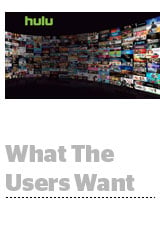 Here’s today’s AdExchanger.com news round-up… Want it by email? Sign-up here.
Here’s today’s AdExchanger.com news round-up… Want it by email? Sign-up here.
Against The Stream
Hulu is dropping its free offering to focus exclusively on subscriptions, while shunting much of the free content it had to Yahoo View, an(other) ad-supported streaming TV service under the Verizon umbrella, reports Variety. You can think of Hulu as a massive experiment undertaken by legacy broadcasters – Comcast, Disney, Fox and Time Warner comprise most of Hulu’s ownership – in the hopes of proving ad-supported TV can undermine Netflix (and now Amazon). Hulu still has commercials in its cheaper package ($7.99 per month compared to ad-free viewing at $11.99), but the latest rethink seems to acknowledge that a whole bunch of people want their TV ad-free. More.
Goliath vs. Goliath
Walmart confirmed rumors from last week that it will pay $3 billion to acquire Jet.com, an ecommerce market startup founded by Marc Lore (who sold his previous ecommerce company to Amazon for $545 million). It’s a great exit for Jet, which raised half a billion dollars, poured huge sums into advertising and then changed its business model when it missed early growth goals. The prevailing consensus is that makes sense for Walmart to spend, overspend even, just to cement its position as the clear No. 2 to Amazon in ecommerce. Read on at The New York Times.
SnapTV
NBCUniversal signed a multiyear deal to create “shows” exclusively for Snapchat, Steven Perlberg of The Wall Street Journal reports. The network will leverage content from “Saturday Night Live,” “The Voice” and “The Tonight Show” to create original Snapchat content. It won’t be used to syndicate popular clips, as is the norm on Facebook and YouTube. “The idea that you’re going to take a horizontal piece of content, even if it’s great, and just crop it vertically isn’t going to work,” said Ron Lamprecht, NBCU’s executive VP of digital distribution. NBCU will sell ads against the videos, teeing up its first potential joint TV/Snapchat buys. More.
The Shopper Code
“We have found that product pricing is key to success in Google Shopping,” writes Crealytics CEO Andreas Reiffen in a column for Search Engine Land. Since Google’s algorithm is opaque, it’s critical to understand how it funnels its shopper queries. To get Google Shopping traffic, you essentially have to lure users with products priced below average among a competitive set. Google gives its users what they want, and people pretty much know a good deal. But most purchases directly from a Google search aren’t the product in the query, so Reiffen says retailers should selectively offer great deals to Google (which equates to high traffic) and then upsell high-margin products on their own sites. More.
Crystal Ball
Writing on LinkedIn, GroupM technical ops director Timothy Whitfield predicts that DMPs and enterprise data clouds will rise, along with other demand-side solutions like location targeting and mobile creative. But he says supply-side tech vendors are in trouble (except for native ad platforms, where he sees rising performance). Unless an SSP is well-established and housed in a full stack, Whitfield doesn’t like the odds. He reserves most of his ire for header bidding, though. “Let me be very clear on this. Any solution that requires more code, more latency, more JavaScript, more data privacy concerns in order to work is a bad solution. Publishers that are thinking about deploying header bidding as a technology should think long and hard before taking that step.” LinkedIn post.
But Wait, There’s More!
- Android Ecosystem Security Flaws A Continuing Concern – Recode
- AdPushup Raises Series A From Japanese SSP – release
- WTF Is A Device Graph? – Digiday
- Which Retailers Are Bracing For Brexit – eMarketer
- Research And Markets: Mobile Messaging Apps Forecast – release
- Jivox Study: Impact Of Digital Ad Personalization – release
- Some Retailers Are Missing Out By Ignoring Snapchat – Adweek












